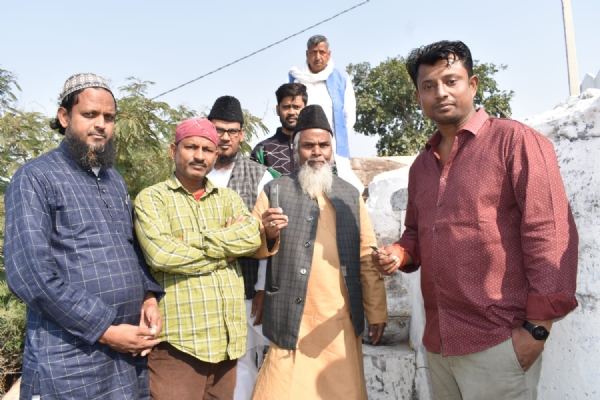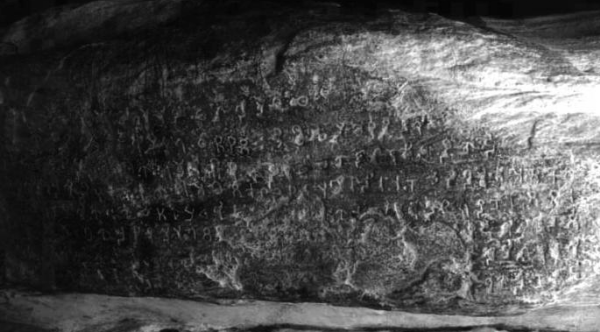Site of Ashokan Edict at Sasaram relieved from Islamic encroachment? Dargah authorities hand over keys to ASI
"The Asoka inscription at Sasaram contains one of the earliest edicts of that Emperor (Minor Rock Edict I)."
Total Views |
In a recent update of the Islamic encroachments on the site of ancient Ashokan edict at Bihar's Sasaram , the Archaeological Survey of India has shared that after long standing encroachments the Dargah authorities have handed over the keys of the monument with the ASI. The Dargah authorities gave the keys to the ASI authorities after, the district authorities have been mediating the issue since a long time.

The issue of Islamic encroachment at the site of Ashokan edict in Sasaram came forth, few months back in this year. In fact, the Pali Research Institute of Mumbai had shared a video on YouTube referring to the seriousness and details of the problem of Islamic encroachment on the historic land of Ashoka, even earlier. In the video, it has been mentioned that despite of several requests from the locals, the district authorities as well as the Archaeological Survey of India, the Dargah authorities have kept the doors of the monument locked. And after years, it has happened today that the authorities have shared the keys with the ASI.
Few months back the news was broke whereby it was known that the Ashoka's edict at Sasaram was encircled by unlawful construction around it. A Mazar has been constructed surrounding the site of Ashoka's edict, covering the white lime coat with green cloth. The Dargah, that is constructed after encroaching upon a protected historical site, is also a prominent place of worship for local Muslims as an annual 'Urus' is also organized, whereby it has also been declared that it is the tomb of a Sufi saint. The gate of the monument, however, has remained locked for several years.
ASI listed the Sasaram Ashokan edict site as a protected monument in 2008. The ASI had also put up a conservation board near the inscription at Kandara. According to the earlier reports of OpIndia, the encroachers had reportedly removed the board. In 2008, 2012, and 2018, the ASI ordered that the encroachments surrounding the Ashoka edict be removed by the District Magistrate (DM). Following this, the District Magistrate directed the SDM of Sasaram to take appropriate action.
Also read: SC remembers TN Seshan and LK Advani while hearing about the process to appoint CEC and ECs
The SDM had ordered the Markazi Muharram Committee, which had illegally encroached on the site, to immediately hand over the key to the administration, but the committee refused. A large structure was gradually constructed illegally there. And after a long period, in Nov 2022, the keys to the protected monument have finally been handed over to the ASI.
The edict of Ashoka at Sasaram is one of the important messages the Mauryan emperor has left behind during his Dhamma Parikrama. Thus, the place possesses immense significance not only to Buddhists but for the history of India. British Archeologists have described the site in their record saying; ''In a small cave now called Chiragh-dan or lamp-room of Pir Chandan Shahid, and some 30 feet to the west of the Shahid's grave, which is situated on the summit of the Chandan Pir Hill some 3 miles east of the town."

As per their records, Ashoka was the most illustrious king of the Maurya dynasty and that after his conquest of Kalinga in Orissa, struck with remorse at the suffering he caused, he converted to Buddhism and spent the rest of his life propagating his dharma (law).
The Archeologist further continues in his description, "In order to achieve this, he had numerous edicts inscribed on rocks, pillars and caves, throughout his vast empire. These are written in the various vernaculars and represent the earliest written document from the Indic regions. From these edicts it appears that Ashoka was an extremely tolerant and benevolent monarch."
In the 'List of Ancient Monuments...of Bihar and Orissa' of 1931, M.M.H. Kuraishi wrote, "The Asoka inscription at Sassaram contains one of the earliest edicts of that Emperor (Minor Rock Edict I). It is engraved on a small boulder and consists of 8 lines in archaic Brahmi characters...A portion of the inscription is damaged."
---



